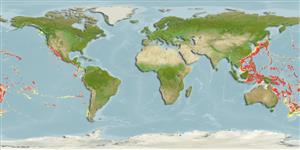Environment: milieu / climate zone / depth range / distribution range
Ecología
marino batidemersal; rango de profundidad 100 - 1200 m (Ref. 559). Deep-water
Pacific Ocean: Philippines and Kyushu-Palau Ridge, near the Hawaiian Islands and the Sala y Gomez Ridge.
Tamaño / Peso / Age
Maturity: Lm ? range ? - ? cm
Max length : 15.0 cm SL macho / no sexado; (Ref. 559)
Espinas dorsales (total) : 7; Radios blandos dorsales (total) : 10. Well-developed opercular spines present. Distance between anal opening and the beginning of the anal fin is 27-41 percent of the distance between the base of pelvic fin and the anal opening (Ref. 31632).
A mesobenthic-pelagic species living mainly above the bottom (Ref. 31632). Inhabits tops of seamounts (Ref. 559). Aggregations hovered over sand patches near steep, irregular cliffs (Ref. 7460).
Life cycle and mating behavior
Madurez | Reproducción | Puesta | Huevos | Fecundidad | Larva
Abramov, A.A., 1992. Species composition and distribution of Epigonus (Epigonidae) in the world ocean. J. Ichthyol. 32(5):94-108. (Ref. 31632)
IUCN Red List Status (Ref. 130435: Version 2024-1)
Threat to humans
Harmless
Human uses
Herramientas
Special reports
Download XML
Fuentes de Internet
Estimates based on models
Preferred temperature (Ref.
123201): 5.8 - 16.8, mean 10.1 °C (based on 252 cells).
Phylogenetic diversity index (Ref.
82804): PD
50 = 0.5000 [Uniqueness, from 0.5 = low to 2.0 = high].
Bayesian length-weight: a=0.00646 (0.00275 - 0.01515), b=3.10 (2.89 - 3.31), in cm total length, based on LWR estimates for this (Sub)family-body shape (Ref.
93245).
Nivel trófico (Ref.
69278): 3.5 ±0.5 se; based on size and trophs of closest relatives
Resiliencia (Ref.
120179): Medio, población duplicada en un tiempo mínimo de 1.4-4.4 años (Assuming tm=2-4).
Fishing Vulnerability (Ref.
59153): Low vulnerability (10 of 100).
